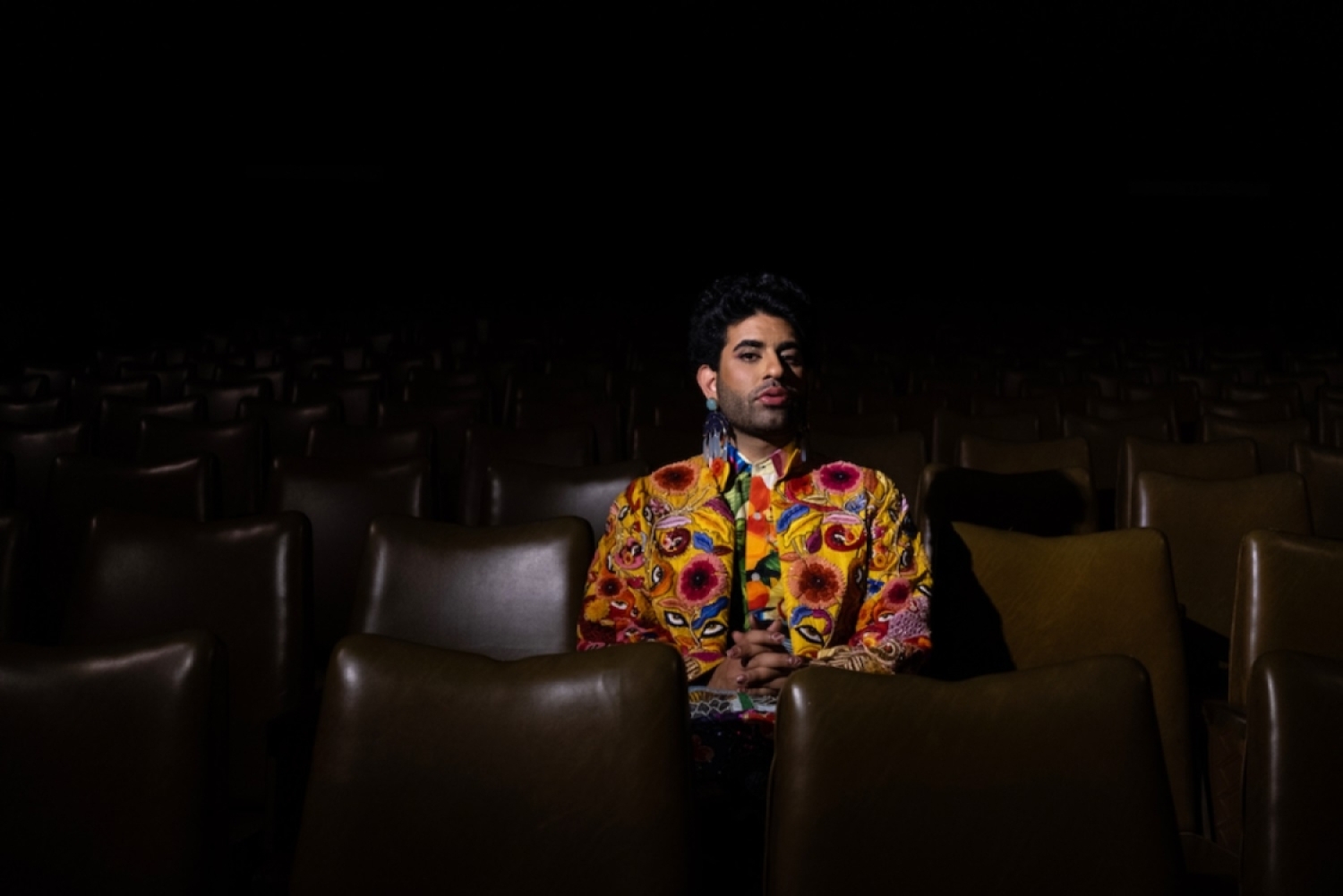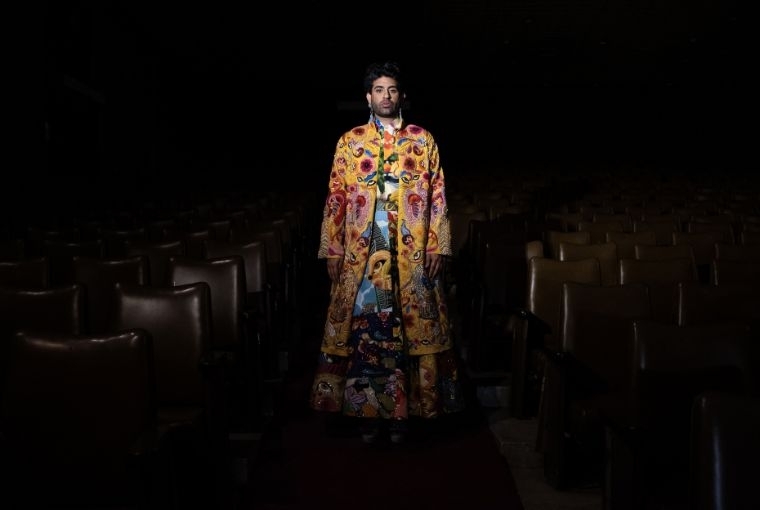

The freedom of self-expression often feels out of reach for many of us, drawing us towards idols who embody the possibility of that desired freedom. Author and Performance Artist, Alok Vaid-Menon, upholds the freedom to fully accept oneself and express it regardless of any societal expectations. Through education and the power of language, Menon challenges societal norms that seek to confine individuals to narrow boxes, whether through beauty standards or cis-het expectations. Their rebellion is rooted in love and compassion, even for those who oppose their choices, highlighting that we are all conditioned to internalise self-hatred, which in turn leads us to resent those who embrace their freedom. To dismantle cis-het norms, Menon advocates for responding with love to those who oppose the idea of being different. Their performances, blending poetry and comedy, defy conventional forms, fostering a sense of fluidity in our perception of the world.
Menon amplifies their experiences with writing, social media, activism and more, inviting us to reconsider our understanding of identity and give ourselves the opportunity to just be.
What do you think poetry and comedy—a rare combination—brings to your artistic performance?
Being human is not a passive state of being, it’s some- thing that we must constantly practice. Being human means learning how to hold both. So much of what inspires my creative practice is a commitment to finding harmony where we have been taught dissonance, dis- solving the dichotomies that structure our social reality: gravity/levity, sadness/joy, grief/gratitude. These states of being don’t exist in competing planes and it is dishonest to pretend that they do. They can be simul- taneous, braided. They need each other. What combin- ing poetry and comedy allows me to do is to appreciate this fundamental principle: the sorrow in joy/the joy in sorrow/the superficiality in the serious/the serious in the superficial.
Also – I just have a lot of fun doing it. So, there’s that.
Since you are also an author, how is writing a performance different from writing a book and what establishes your relationship with writing?
Each art form contributes something meaningful to me. I don’t experience a preference or hierarchy. I need them all. Writing for a book means people can return to the text to find themselves in the narrative. In performance you need to have more signposts, more ways of reorienting people back to where they are in the piece. In page writing, I can be more colourful with language and grammar; in performance, it’s often about which words sound like, the easiest way to distil a complex idea. Performance writing also must consider an audience: their laughter, their applause, their tears. Whereas in writing a book, I have to grapple with that audience of one: myself, my harshest critic.
What do you hope your viewers to take away from your performance?
I’ve toured across the world for over a decade now, I’ve learned that often a country isn’t the most useful con- tainer to hold an audience. Within countries, there is so much variance. Sometimes it’s more about the venue, the promoter, the time of day, what’s going on in the world. Often, we are looking for stories to populate our pre-existent paradigms of what a certain place ‘is’. We forget how nothing actually ‘is’, everything is in a constant state of becoming and performance isn’t just something the crowd observes passively, it’s something that shapes the crowd itself and the audience shapes the performer.
This is all a longwinded way of saying, it’s complicated and that my job as a performer is to read the room and pivot accordingly and that the room is often a better indicator than a larger unit of measure. My hope is that my performances give people a greater sense of permission: permission to wear what they want to wear, permission to cry, permission to feel joy, permission to be.

You have emphasised on shifting the location of transgender issues to non-trans people. In your performance as well, you make the non-marginalised feel what it is like to be in the shoes of themarginalised. How did you first realise that the root of marginalisation stems from the people who hate on themselves?
This was less of a cognitive realisation, more of an embodied one. I can’t describe to you what it feels like to be the only transfeminine person in a public space. Sure, there arewords I could use to reflect it, but they’ll always fall short of the feeling. The glares and glances, the jeers and slurs and giggles and the more time I spent having to watch people watch me, having to feel the weight of their gazes, the way they moved around me, receive their vitriol, the more I realised that this has nothing to do with me.
One of my greatest teachers, James Baldwin, said that it’s ‘astonishing the lengths to which a person will go in order to avoid a truthful mirror’. This is the best workingdefinition for transphobia I’ve encountered. Transphobia is everyone’s attempt (including trans people) to not have to truly witness ourselves: our jagged edges, the ways that we do not and cannot fit into pre-ordained social categories, our complicatedness, our overwhelming grief, our profound humanness.
I feel it there in public – people siphoning their own shame on to me. People reproducing the policing that they have gone through onto me, thinking that will bring them some sense of resolution or security. I see that it doesn’t, ultimately. That’s the thing about hatred and prejudice, they are fleeting senses of stability. Love is the only endurant force.
Since you often focus on challenging hatred on social media and more often than not, people encounter a lot of hate for being just different, how do you think people can accept their self in such a hostile environment?
Certainly, that’s one story of what’s going on but alongside it – there is the story of people across the world doing that seemingly impossible work of accepting who they are. It’s helpful to notice and study those stories. How are people interrupting intergenerational trauma and cycles of shame? How do people demonstrate courage in the face of coercion? By finding other people who feel their loneliness and deciding to do something about it, by creating a new language, by adopting strategies that are immediately dismissed as naive and idealistic.
For many of us, belonging required us to compartmentalise ourselves, minimise our differences in order to fit in. But a different standard of belonging – one that encourages us to become the fullest version of ourselves is also materialising. I try to keep my finger on that pulse. It’s what gives me hope.
Tell us about the interactions you had with Indian queer folks and how you resonate with as an Indian-American?
In my early twenties, I had a lot of angst that I’d never be able to reconcile being Indian with being queer. I didn’t know many queer Indian people and I felt like I had to continually juggle different parts of myself. I moved to India to connect with more queer Indian people, I ended up making some of my best friends. For over a decade these relationships have been incredibly important and grounding to me. There’s a profound sense of security and silliness. We feel like a family.
How do you think we can actually practice a world where gender is not a criterion for social classification without tokenisms?
This world is already here, being practiced right now, with queer communities across the world. Sure, it’s awkward sometimes and by and large we are figuring it out as we go, but we have equal measure, grace and conviction. There’s a way in which moving beyond gender norms gets dismissed as far-fetched and fantastical, but I see it this way: it’s ludicrous that we think we can continue to police billions of complex souls into one of two genders. That’s not a sustainable strategy – because humans, human. We continually irritate every attempt to contain us – because we change. So, in creating a world beyond gender norms, we must learn how to appreciate change as a necessary worldmaking practice.
Words Paridhi Badgotri
Photography Riti Sengupta
Date 29.06.2024